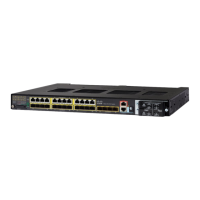-767
Cisco Industrial Ethernet 4000 Series Switch Software Configuration Guide
Chapter Configuring HSRP and VRRP
Understanding HSRP
Configuring HSRP and VRRP
This chapter describes how to use Hot Standby Router Protocol (HSRP) to provide routing redundancy
for routing IP traffic not dependent on the availability of any single router. HSRP for IPv4 is supported
on switches running the IP services image.
You can also use a version of HSRP in Layer 2 mode to configure a redundant command switch to take
over cluster management if the cluster command switch fails.
For complete syntax and usage information for the commands used in this chapter, see these documents:
• Cisco IOS IP Command Reference, Volume 1 of 3: Addressing and Services, Release 12.2 at
http://www.cisco.com/en/US/docs/ios/12_2/ipaddr/command/reference/fipras_r.html
• Hot Standby Router Protocol Version 2 feature module at
http://www.cisco.com/en/US/docs/ios/12_3t/12_3t4/feature/guide/gthsrpv2.html
This chapter consists of these sections:
• Understanding HSRP, page -767
• Configuring HSRP, page -770
• Displaying HSRP Configurations, page -778
• Configuring VRRP, page -778
Understanding HSRP
HSRP is Cisco’s standard method of providing high network availability by providing first-hop
redundancy for IP hosts on an IEEE 802 LAN configured with a default gateway IP address. HSRP routes
IP traffic without relying on the availability of any single router. It enables a set of router interfaces to
work together to present the appearance of a single virtual router or default gateway to the hosts on a
LAN. When HSRP is configured on a network or segment, it provides a virtual Media Access Control
(MAC) address and an IP address that is shared among a group of configured routers. HSRP allows two
or more HSRP-configured routers to use the MAC address and IP network address of a virtual router.
The virtual router does not exist; it represents the common target for routers that are configured to
provide backup to each other. One of the routers is selected to be the active router and another to be the
standby router, which assumes control of the group MAC address and IP address should the designated
active router fail.
Note Routers in an HSRP group can be any router interface that supports HSRP, including routed ports and
switch virtual interfaces (SVIs).
HSRP provides high network availability by providing redundancy for IP traffic from hosts on networks.
In a group of router interfaces, the active router is the router of choice for routing packets; the standby
router is the router that takes over the routing duties when an active router fails or when preset conditions
are met.
HSRP is useful for hosts that do not support a router discovery protocol and cannot switch to a new router
when their selected router reloads or loses power. When HSRP is configured on a network segment, it
provides a virtual MAC address and an IP address that is shared among router interfaces in a group of

